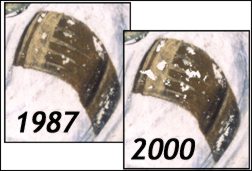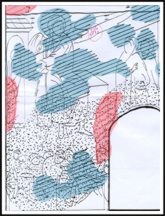BLAGO BLOG
OUR BLOG
Article Index
FRESCO: THE WHITE ANGEL
Possibly the most famous work of medieval Serbian visual arts, the White Angel is actually part of a larger composition, Myrrh-bearing women at the Holy Sepulcher, located at the southern side of the naves west arm at Mileseva. The fresco dates back to the 13th century, but in its present form remained unknown until modern times, when removal of a heavily damaged newer overlay fresco from the 16th century revealed the original layer. A horizontal belt of the overlay with partial inscription remains.
For the several areas of the painting - including the sleeve decoration zone - that contain portions of fresco layer partially separated from the base layer and with a tendency to fall off, it is crucial to perform timely conservation work that would fix these parts, simultaneously limiting the spread of this damage and appearance of a new similar one. In the areas where surface chipping and lamination have already occurred, the holes need to be restored and retouched with a paste of corresponding color and texture. Surface sediments, particularly those that appear within paintbrush grooves, should be removed by a combined physical-chemical process. Salt deposits that are found in the angel's left-wing and in parts of the lower zone of the fresco are of low adhesion and should be removed by mild conservation methods.
The unfinished edge of the newer fresco mortar layer (above the angel's head) should be appropriately processed, by suturing, consolidation and tonal equalization.
Conservation work undertaken in 1972 has noted some lamination of the base mortar layer that connects the fresco to the wall. A comparison of three surveys performed since 1988 further revealed surface separation of the old layer in certain areas during this period, including that of the angels left sleeve. There are several possible causes for this recent damage. Part of it is attributable to the fact this area was among the last painted in the fresco-process for this composition; as such its bonding to the mortar base is weakest, compounded by the particular sensitivity of the yellow colors in question. |
Other influences may come from the paintings initial exposure to the elements prior to the addition of the top layer, some damaging processes that may have continued under the top layer, as well as partial adhesion to it. The key point, however, is that since the discovery of this fresco composition neither a full structural analysis of paint layers nor their consolidation has been performed, and there are verified multiple areas of modern-era natural damage, with a potential of exacerbation. Conservation report warnings to this effect exist since 1995.
SLEEVE AREA DAMAGE
|
|||||||
More Information
BLAGO Content
While the content of the BLAGO Fund collections is free to use, there are also some restrictions on commercial use and proper attribution of the material. Follow the links below for more information.
> BLAGO Collections License
> Image Request
BLAGO Fund also accepts the contribution of material. Please contact us with any material you wish to publish on our website.
Contact
BLAGO Fund, Inc.
PO Box 60524
Palo Alto, CA 94306
USA
info@blagofund.org




